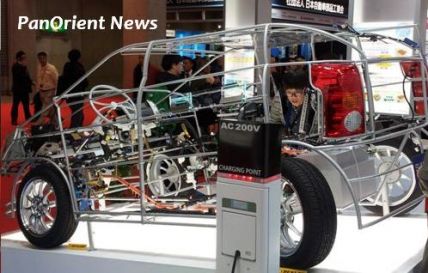|
|
Sci-Tech
Toyota, Nissan, Honda and Mitsubishi to Jointly Develop Charging Infrastructure
Monday, July 29, 2013

Tokyo- (PanOrient News)Toyota Motor Corporation, Nissan Motor Co., Ltd., Honda Motor Co., Ltd., and Mitsubishi Motors Corporation today jointly announced their agreement to work together to promote the installation of chargers for electric-powered vehicles such as plug-in hybrid vehicles (PHV); plug-in hybrid electric vehicles (PHEV), and electric vehicles (EV), and build a charging network service that offers more convenience to drivers in Japan.
This move comes at a time in which charging infrastructure facilities are necessary to promote the use of electric-powered vehicles. Assisted by subsidies provided by the Japanese government, the four automakers will bear part of the cost to install the charging facilities and build a more convenient and accessible charging network.
Based on data collected from the companies, at present there are about 1,700 quick chargers and just over 3,000 normal chargers in Japan, which is generally recognized to be insufficient. In addition, there is a lack of coordination among existing charging providers.
The government announced subsidies for installation of charging facilities totaling 100.5 billion yen as part of its economic policy for fiscal year 2013 to quickly develop the charging infrastructure and expand the use of electric-powered vehicles using alternative energy sources.
Currently, there are three charging methods for electric-powered vehicles: basic charging, where a car is charged at private homes or condominiums; destination charging, where a car is charged at locations such as shopping malls, DIY stores and family restaurants for the return trip home; and en-route charging at locations including expressway roadside service areas, roadside stations (michi no eki), gas stations, and convenience stores. In both destination and en-route charging, normal charging is suitable for longer-duration stops, while quick charging is appropriate for shorter stops. Studies are underway to increase the number of normal chargers up to a total of 8,000 and quick chargers up to a total of 4,000.
Actions also include promoting charger installation by temporarily bearing part of the installation and maintenance costs, the statement said, noting this would involve building a charging infrastructure network which enables customers to use their PHVs, PHEVs and EVs more conveniently. Collaboration among companies currently providing charging services in which each automaker has already invested (Japan Charge Network Co., Ltd., Charging Network Development, llc and Toyota Media Service) would lead to the creation of a more convenient charging infrastructure network. One example is enabling the car’s owner to charge his or her car at any charging spot with the same card.
The government aims to expand the use of the next-generation of these vehicles and have PHVs, PHEVs and EVs achieve a ratio of 15 to 20 percent of new car sales in 2020.
PanOrient News
© PanOrient News All Rights Reserved.
|
|

